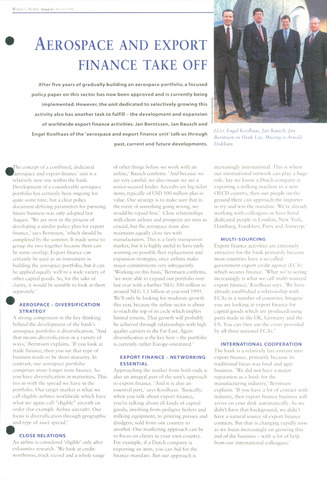Aerospace and export
FINANCE TAKE OFF
WHAT'S NtwS Issue 3 March 1996
After five years of gradually building an aerospace portfolio, a focused
policy paper on this sector has now been approved and is currently being
implemented. However, the unit dedicated to selectively growing this 1
I
activity also has another task to fulfill - the development and expansion f
O
of worldwide export finance activities. Jan Berntssen, Jan Bausch and
Engel Koolhaas of the 'aerospace and export finance unit' talk us through
past, current and future developments.
f.l.t.r. Engel Koolhaas, Jan Bausch, Jan
Berntssen en Henk Lijs. Missing is Arnold
Dokkum
IThe concept of a combined, dedicated
'aerospace and export finance' unit is a
relatively new one within the bank.
Development of a considerable aerospace
portfolio has certainly been ongoing for
quite some time, but a clear policy
document defining parameters for pursuing
future business was only adopted last
August. 'We are now in the process of
developing a similar policy plan for export
finance,' says Berntssen, 'which should be
completed by the summer. It made sense to
group the two together because there can
be some overlap. Export finance can
certainly be used as an instrument in
building the aerospace portfolio, but it can
be applied equally well to a wide variety of
other capital goods. So, for the sake of
clarity, it would be sensible to look at them
separately.'
AEROSPACE - DIVERSIFICATION
STRATEGY
A strong component in the key thinking
behind the development of the bank's
aerospace portfolio is diversification. 'And
that means diversification in a variety of
ways,' Berntssen explains. 'If you look at
trade finance, then you see that type of
business tends to be short-maturity. In
contrast, our aerospace portfolio
comprises more longer term finance. So
you have diversification in maturities. This
ties in with the spread we have in the
portfolio. Our target market is what we
call eligible airlines worldwide which have
what we again call "eligible" aircraft on
order (for example Airbus aircraft). Our
focus is diversification through geographic
and type of asset spread.'
CLOSE RELATIONS
An airline is considered 'eligible' only after
exhaustive research. 'We look at credit-
worthiness, track record and a whole range
of other things before we work with an
airline,' Bausch confirms. 'And because we
are very careful, we also ensure we are a
senior-secured lender. Aircrafts are big ticket
items, typically of USD 100 million plus in
value. Our strategy is to make sure that in
the event of something going wrong, we
would be repaid first.' Close relationships
with cliënt airlines and prospects are seen as
crucial, but the aerospace team also
maintains equally close ties with
manufacturers. This is a fairly transparent
market, but it is highly useful to have early
warning on possible fleet replacement and
expansion strategies, since airlines make
major commitments very infrequently.
'Working on this basis,' Berntssen confirms,
'we were able to expand our portfolio over
last year with a further NLG 300 million to
around NLG 1.1 billion at year-end 1995.
We'11 only be looking for moderate growth
this year, because the airline sector is about
to reach the top of its cycle which implies
limited returns. That growth will probably
be achieved through relationships with high
quality carriers in the Far East. Again
diversification is the key here - the portfolio
is currently rather Europe-orientated.'
EXPORT FINANCE - NETWORKING
ESSENTIAL
Approaching the market front both ends is
also an integral part of the unit's approach
to export finance. 'And it is also an
essential part,' says Koolhaas. 'Basically,
when you talk about export finance,
you're talking about all kinds of capital
goods, anything from pedigree heifers and
milking equipment, to printing presses and
dredgers, sold from one country to
another. One marketing approach can be
to focus on clients in your own country.
For example, if a Dutch company is
exporting an item, you can bid for the
finance mandate. But our approach is
increasingly international. This is where
our international network can play a huge
role. Say we know a Dutch company is
exporting a milking machine to a non-
OECD country, then our people on the
ground there can approach the importer
to try and win the mandate. We're already
working with colleagues or have hired
dedicated people in London, New York,
Hamburg, Frankfurt, Paris and Antwerp.'
MULTI-SOURCING
Export finance activities are extremely
attractive for the bank primarily because
most countries have a so-called
government export credit agency (ECA)
which secures finance. 'What we're seeing
increasingly is what we call multi-sourced
export finance,' Koolhaas says. 'We have
already established a relationship with
ECAs in a number of countries. Imagine
you are looking at export finance for
capital goods which are produced using
parts made in the UK, Gerntany and the
US. You can then use the cover provided
by all three national ECAs.'
INTERNATIONAL COOPERATION
The bank is a relatively late entrant into
export finance, primarily because its
traditional focus was food and agri-
business. 'We did not have a major
reputation as a bank for the
manufacturing industry,' Berntssen
explains. 'If you have a lot of contact with
industry, then export finance business will
arrivé on your desk automatically. As we
didn't have that background, we didn't
have a natural source of export finance
contacts. But that is changing rapidly now
as we focus increasingly on growing this
end of the business - with a lot of help
from our international colleagues.'

